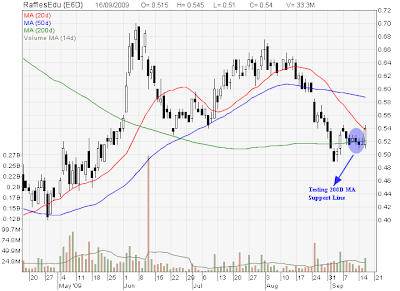How do I value a stock?
There are 3 different methods of doing a stock valuation.
- Simple Price / Earning (PE) Ratio & PEG
- Discounted Cash Flow (DCF)
- Discounted Earning Per Share (EPS)
Simple PE Ratio & PEG
As a general guideline, a company is at its fair value if the PE is about 15. If the PE ratio less than 15, it is considered under value, and vice versa. I also do a quick comparison of current PE versus the average PE historically. I will pay special attention to the stock price movement if the current PE is more higher than the historical PE average.
PEG refers PE ratio divided by company growth rate. PEG = 1 means that PE growth rate is the same as the company growth rate (measured by either EPS growth rate or net operating cash flow growth rate)
If PEG < 1, the stock price is under value.
If PEG > 1, the stock price is over value.
If PEG = 1, the stock price is at its fair value.
Discounted Cash Flow Model (DCF)
This model is to estimate the company next 10 years net operating cash flow (Future Value, FV) and re-calculate to the Present Value (PV), and add all ten years PV together. The intrinsic value can be calculated after dividing the total number of shares,. The assumption made is the company must be able to generate cash growth consistently with a CAGR (Compounded Annual Growth Rate) which computed from the past history of net operating cash flow.
Net Operating Cash Flow information can be found from the company annual reports, under the Cash Flow Statement.
Discounted Earning Per Share Model (EPS)
Similar to the DCF model, but this time Earning Per Share is being looked into. EPS information can be found at the Income Statement by getting the Net Earning number and divided by the total number of shares. By looking at the historical EPS, a CAGR for EPS growth can be calculated.
By bringing all the 10 years FV of EPS to PV, adding them together give an intrinsic value of the stock.
Valuation of a stocks need some financial background and need some practice. Two key areas to pay attention to:
(1) Where to find the information? All the financial statement can be found from the annual reports by going to the company web site. Another way is to get the summarised information from the website like Shareinvestor (for Singapore Stocks), Morningstar & MSN Money (for US Stocks)
(2) Understand the Financial Fundamental & Definitions like Present Value, Future Value, Discount Rate, CAGR and also practise how to use them. I use the financial calculator to calculate the CAGR and instrinsic value calculator to calculate the intrinsic value of the stocks. I got those simple software (formula in excel form) from my investment course.
I found that DCF model is a better model although it is a little more complicated because Cash Flow is not easily manipulated by the company accountant and cash is always easily be audited. If the company business model is solid, the net operating cash flow grows consistently every year. On the other hand, good EPS numbers do not mean the company is increasing the sales revenue and gaining competitive advantage to expand the market share. EPS can be manipulated easily as the company accountant can add whatever provision they want, using different amortization or depreciation method or using different revenue recognition method. Furthermore, the company can make the EPS more attractive by buying back shares, doing all sorts of cost cutting internally (like selling company fixed assets) to make the number looks nice.
After the intrinsic value is calculated, I compare the current stock price with the intrinsic value. If the current stock price is at least 20% discount to the intrinsic value, I will put the stocks in my watchlist and wait for the right time to buy. I will share in the next post on how I time my entry.










